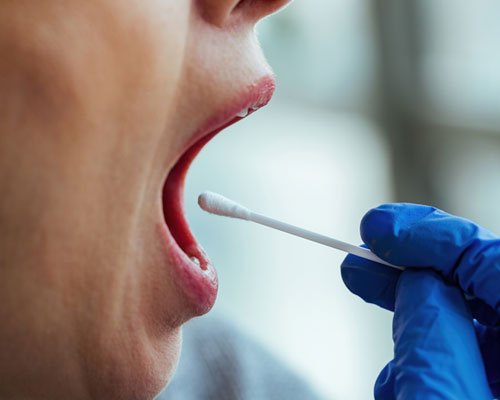A Systematic Review Literature of Treatments for Sjögren’s Syndrome Xerostomia
November 13, 2023 | Dry Mouth / Sjögren’s syndrome / Xerostomia

In September, a team of researchers from Ecuador and Ukraine conducted a systematic literature review (SLR) of treatments and preventative strategies for primary Sjögren’s Syndrome (SS).
The researchers honed in on 10 seminal articles that met their strict inclusion criteria to provide a comprehensive overview of primary Sjögren’s Syndrome treatment, including diagnostic tools and associated biomarkers indicative of lymphoma risk. They found that there are multiple treatment types for Sjögren’s Syndrome and recommend using a combination to achieve the best results.
Please note: Specific treatments for xerostomia are not discussed in this article. Among those, common approaches include pharmacologic stimulation of salivary glands such as pilocarpine and cevimeline, topical agents like mouthwashes and gels, and electrostimulation as provided by the SaliPen device manufactured by Saliwell Ltd.
Sjögren’s Syndrome Symptoms
Sjögren’s syndrome is a chronic immune disorder and one of its main symptoms is hyposalivation, i.e. decreased salivary production. This directly causes dry mouth, clinically termed xerostomia. The challenges of decreased salivary production include complications in articulation, chewing food, swallowing, and wearing removable dental prosthetics.
In addition to dry mouth, primary SS can also cause dryness in other areas of the body, which is clinically categorized as “sicca syndrome” or “sicca complex”.
SS can often lead to the degradation of salivary and lacrimal glands, elevating the risk for non-Hodgkin’s lymphoma. Additionally, people with primary SS often experience oral health issues, including:
- Glossodynia (burning mouth syndrome)
- Glossitis (inflammation of the tongue)
- Accelerated dental decay
- Oral yeast infections
- Angular cheilitis (inflammation and small cracks in the corners of the mouth)
- Dysgeusia (altered taste)
- Traumatic oral lesions
- Acute infections in major salivary glands
Primary SS (as opposed to secondary SS) is when there is no other underlying rheumatic disorder, while secondary SS is when the occurrence of SS is associated with another underlying rheumatic disorder.
Quality of Life
The health-related quality of life (HRQoL) metrics for people with primary SS are similar to those with more aggressive autoimmune disorders like rheumatoid arthritis and systemic lupus erythematosus.
Scientists have developed several tools to help them assess the effects of oral health on quality of life. The Oral Health Impact Profile (OHIP) is one of the most comprehensive and widely used measures, and research shows that primary SS patients score consistently lower on it than standard control groups.
Additionally, the European League Against Rheumatism (EULAR) developed the EULAR Sjögren’s Syndrome Disease Activity Index (ESSDAI) in 2009 for objective assessment and EULAR Sjögren’s Syndrome Patient Reported Index (ESSPRI) in 2011. The latter is a self-reporting tool that measures fatigue, discomfort, and sicca symptom inventory — it’s often used in research and clinical studies.
About the Study
In the researchers’ systematic review, they employed rigorous methodological standards outlined in the PRISMA guidelines, ensuring a comprehensive and transparent approach. PRISMA guidelines include a 27-point checklist to improve transparency in systematic reviews and meta-analyses.
The researchers surveyed five reputable databases:
- PubMed
- PubMed Central
- Google Scholar
- Web of Science
- The Cochrane Library
The researchers also used several tools to ensure high standards of their research. These included:
- The Assessment of Multiple Systematic Reviews (AMSTAR) checklist: Used to evaluate the “methodological rigor of the included systematic reviews.”
- The Cochrane risk of bias assessment tool: Used to assess potential bias in clinical trials they reviewed.
- Newcastle-Ottawa Quality Assessment Scale: Used to assess non-randomized studies.
- The Scale for the Assessment of Narrative Review Articles (SANRA): Used to evaluate the quality of narrative reviews.
The search performed in the five databases yielded hundreds of relevant results. To determine those eligible to be included in the systematic review of primary SS treatments, two investigators worked methodically to narrow down the selection.
Afterwards, the investigators scrutinized the relevant articles in detail.
Review Results
The initial search turned up 631 studies, but 543 were automatically disqualified because they didn’t meet the inclusion criteria. That left 88 studies for the investigators to screen by their titles and abstracts, which further narrowed down the pool to 14 articles. After eliminating duplicates, 10 articles remained for the final collection of data.
The researchers then performed a thorough review of the multiple treatment options for SS as outlined in the articles. They focused specifically on the effects of oral healthcare products on patients’ self-reported health results. The researchers also determined the best-suited lab tests for early detection of SS and discussed biological indicators of lymphoma.
Noteworthy findings include:
- Those with primary SS have significantly worse oral health than those who don’t, as measured by saliva production, acidic salivary pH levels, periodontal diseases, and decreased quality of oral health.
- Randomized control studies showed that antioxidants have the potential to act as a preventative measure and treatment for these issues.
- Natural remedies have the potential to be used as treatment. They act by suppressing harmful autoantigens, modulating antioxidant enzymes, and affecting cell growth pathways.
- It’s important to achieve an accurate diagnosis of SS, separating those with genuine symptoms from those with subjective complaints.
- Understanding the diverse roles of saliva is crucial for creating effective treatment plans.
- Survival rates for those with SS and the general population are fairly comparable.
- People with SS can have dental implants.
- The saliva of SS patients may be able to identify potential biomarkers or indicators for lymphoma.
Conclusion
The study concluded that there are no standard treatment guidelines for xerostomia, but there are a variety of approaches for disease management. Researchers’ findings support the use of a “multi-modal therapy strategy” for the treatment of xerostomia in people with primary SS, i.e. offering multiple treatments at the same time. Therapies include bactericidal herbal remedies, antioxidants, and targeted pharmaceutical therapies that modify cellular responses.
Comment
Specific treatments that are used to treat xerostomia are not discussed in this article. Among those, common approaches include pharmacologic stimulation of salivary glands such as pilocarpine and cevimeline, topical agents like mouthwashes and gels, and electrostimulation as provided by the SaliPen device manufactured by Saliwell Ltd.
Source: Cooley D E, Jaramillo A P, Muñoz Armijos K N (September 22, 2023) Evaluating the Efficacy and Safety of Therapeutic Interventions in Sjögren’s Syndrome: A Systematic Review Literature. Cureus 15(9): e45751. DOI 10.7759/cureus.45751.

